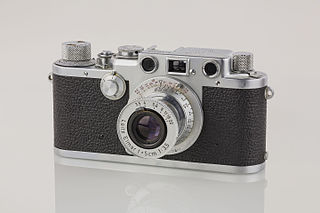
A camera is an optical instrument that captures a visual image. At a basic level, cameras consist of sealed boxes, with a small hole that allows light through to capture an image on a light-sensitive surface. Cameras have various mechanisms to control how the light falls onto the light-sensitive surface. Lenses focus the light entering the camera. The aperture can be narrowed or widened. A shutter mechanism determines the amount of time the photosensitive surface is exposed to light.

Bausch + Lomb is an eye health products company based in Laval, Quebec, Canada. It is one of the world's largest suppliers of contact lenses, lens care products, pharmaceuticals, intraocular lenses, and other eye surgery products. The company was founded in Rochester, New York, in 1853 by optician John Bausch and cabinet maker turned financial backer Henry Lomb. Until its sale in 2013, Bausch + Lomb was one of the oldest continually operating companies in the United States.

Astrophotography, also known as astronomical imaging, is the photography or imaging of astronomical objects, celestial events, or areas of the night sky. The first photograph of an astronomical object was taken in 1840, but it was not until the late 19th century that advances in technology allowed for detailed stellar photography. Besides being able to record the details of extended objects such as the Moon, Sun, and planets, modern astrophotography has the ability to image objects invisible to the human eye such as dim stars, nebulae, and galaxies. This is done by long time exposure since both film and digital cameras can accumulate and sum photons over these long periods of time.

A box camera is a simple type of camera, the most common form being a cardboard or plastic box with a lens in one end and film at the other. They were sold in large numbers during the late 19th and early 20th centuries. The lenses are often single element designs meniscus fixed focus lens, or in better quality box cameras a doublet lens with minimal possible adjustments to the aperture or shutter speeds. Because of the inability to adjust focus, the small lens aperture and the low sensitivity of the sensitive materials available, these cameras work best in brightly lit day-lit scenes when the subject is within the hyperfocal distance for the lens and of subjects that move little during the exposure. Eventually, box cameras with photographic flash, shutter and aperture adjustment were introduced, allowing indoor photos.

Carl Zeiss AG, branded as ZEISS, is a German manufacturer of optical systems and optoelectronics, founded in Jena, Germany in 1846 by optician Carl Zeiss. Together with Ernst Abbe and Otto Schott he laid the foundation for today's multi-national company. The current company emerged from a reunification of Carl Zeiss companies in East and West Germany with a consolidation phase in the 1990s. ZEISS is active in four business segments with approximately equal revenue, Industrial Quality and Research, Medical Technology, Consumer Markets and Semiconductor Manufacturing Technology in almost 50 countries, has 30 production sites and around 25 development sites worldwide.

A catadioptric optical system is one where refraction and reflection are combined in an optical system, usually via lenses (dioptrics) and curved mirrors (catoptrics). Catadioptric combinations are used in focusing systems such as searchlights, headlamps, early lighthouse focusing systems, optical telescopes, microscopes, and telephoto lenses. Other optical systems that use lenses and mirrors are also referred to as "catadioptric", such as surveillance catadioptric sensors.

The Maksutov is a catadioptric telescope design that combines a spherical mirror with a weakly negative meniscus lens in a design that takes advantage of all the surfaces being nearly "spherically symmetrical". The negative lens is usually full diameter and placed at the entrance pupil of the telescope. The design corrects the problems of off-axis aberrations such as coma found in reflecting telescopes while also correcting chromatic aberration. It was patented in 1941 by Russian optician Dmitri Dmitrievich Maksutov. Maksutov based his design on the idea behind the Schmidt camera of using the spherical errors of a negative lens to correct the opposite errors in a spherical primary mirror. The design is most commonly seen in a Cassegrain variation, with an integrated secondary, that can use all-spherical elements, thereby simplifying fabrication. Maksutov telescopes have been sold on the amateur market since the 1950s.

John Henry Dallmeyer, Anglo-German optician, was born at Loxten, Westphalia, the son of a landowner.

Johan (John) Jacob Bausch was a German-American maker of optical instruments who co-founded Bausch & Lomb. Over six decades he transformed his small, local optical shop into a large-scale international enterprise, pioneering the American optical industry.
Questar Corporation is a company based in New Hope, Pennsylvania. It manufactures precision optical devices for consumer, industrial, aerospace, and military markets. Its telescopes produced for the consumer market are sold under the brand name "Questar".

Chance Brothers and Company was a glassworks originally based in Spon Lane, Smethwick, West Midlands, in England. It was a leading glass manufacturer and a pioneer of British glassmaking technology.
The design of photographic lenses for use in still or cine cameras is intended to produce a lens that yields the most acceptable rendition of the subject being photographed within a range of constraints that include cost, weight and materials. For many other optical devices such as telescopes, microscopes and theodolites where the visual image is observed but often not recorded the design can often be significantly simpler than is the case in a camera where every image is captured on film or image sensor and can be subject to detailed scrutiny at a later stage. Photographic lenses also include those used in enlargers and projectors.
Charles Frank Ltd was an optical and scientific instrument maker in Glasgow, Scotland.

Stanhopes or Stanho-scopes are optical devices that enable the viewing of microphotographs without using a microscope. They were invented by René Dagron in 1857. Dagron bypassed the need for an expensive microscope to view the microscopic photographs by attaching the microphotograph at the end of a modified Stanhope lens. He called the devices bijoux photo-microscopiques or microscopic photo-jewelry.

Ernst Gundlach (1834–1908) was a German-American inventor specialising in the design of optical instruments.

W. Watson and Son was an optical instrument maker. In 1837, the William Watson business was established in London for the manufacture of optical instruments. By the 1840s, the company moved into lanterns, slides and associated equipment. In 1868, the name was changed to W. Watson & Son and by this time were located at 313 High Holborn, London. In the 1870s, the company added photographic equipment and became known as a leading manufacturer of the Highest Class Photographic Instruments and Apparatus in England. Into the 1940s, the company remained at 313 High Holborn.
Richard Beck (1827-1866) and Joseph Beck FRAS, FRMS formed the optical manufacturing firm of R and J Beck in 1843, based at 69 Mortimer Street, London,. James Smith worked with the company under the name of Smith and Beck, renamed Smith, Beck and Beck in 1854 but reverting to R and J Beck when Smith retired in 1865. Smith is credited with helping to raise the status of the use of microscopes within scientific research.

The Excelsior Wet Plate Camera is a type of wet plate camera invented by August Semmendinger, one of the first manufacturers of wet plate photography. Excelsior cameras were manufactured in both New York City and Fort Lee, New Jersey starting in 1859.
James Woolley, Sons and Co. Ltd was a firm of pharmacists based in Manchester. It manufactured and sold tablets, pills and capsules of all types, surgical equipment and trusses, talcum powder, health cordials and photographic equipment.


















